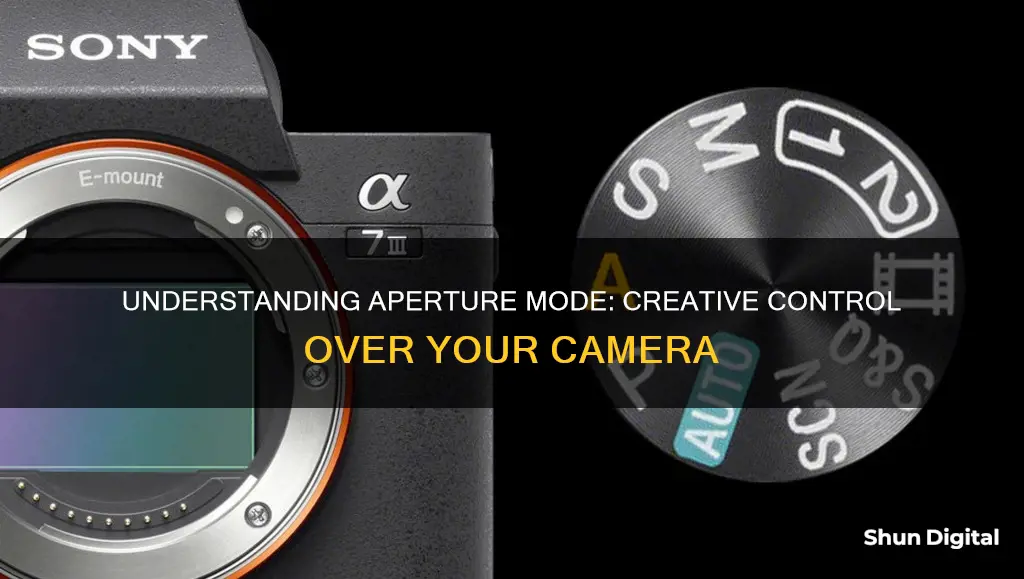
Aperture priority mode is a semi-automatic setting on some cameras that allows the photographer to manually set a specific aperture value (f-number) while the camera automatically selects a matching shutter speed according to lighting conditions. This gives the photographer control over the focus of objects in the frame and is particularly useful for landscape photography, where a large depth of field is desired, and portrait photography, where a smaller depth of field is often preferred.
| Characteristics | Values |
|---|---|
| Type of mode | Semi-automatic |
| Control | Creative control over depth of field |
| Aperture | Manually set by the photographer |
| Shutter speed | Automatically selected by the camera |
| ISO | Automatically selected by the camera |
| White balance | Automatically selected by the camera |
| Use | Portraits, landscapes, macro, creative control |
| Use | When depth of field is critical to achieving the desired creative effect |
| Use | When you need to adjust quickly and lighting conditions are changing |
What You'll Learn

Aperture priority vs manual mode
Aperture Priority and Manual Mode are two camera settings that give photographers control over the exposure triangle, which includes shutter speed, aperture, and ISO. While both modes allow for control over these settings, there are some key differences between the two.
Manual Mode:
In Manual Mode, the photographer has full control over all three elements of the exposure triangle. This mode is often recommended for beginners to learn the relationship between shutter speed and aperture, as well as how the camera handles exposure. It provides a solid foundation for understanding exposure and making creative choices. However, it can be time-consuming, especially in situations with changing lighting conditions, as the photographer has to constantly adjust the settings.
Aperture Priority Mode:
In Aperture Priority Mode, the photographer manually selects the desired aperture value, and the camera automatically adjusts the shutter speed and ISO (if on auto ISO) to achieve the correct exposure. This mode is denoted by "A" or "Av" on most cameras. Aperture Priority gives photographers the advantage of speed and control over technique while ensuring proper exposure. It is particularly useful in situations with changing light, as it allows photographers to set their desired aperture and continue shooting without worrying about adjusting other values. Additionally, Aperture Priority provides full manual control over exposure through exposure compensation, allowing for easy adjustments for dark or light subjects.
Comparison:
Both Aperture Priority and Manual Mode have their advantages and are suitable for different scenarios. Aperture Priority is ideal when photographers want to prioritise aperture and depth of field while having the camera handle shutter speed. It is excellent for situations with changing light, such as events, sports, or wildlife photography. Manual Mode, on the other hand, offers complete control and is valuable when photographers want to make precise adjustments to all aspects of the exposure triangle. It is best suited for situations with consistent lighting, where there is no risk of missing a shot due to adjustments.
In conclusion, both Aperture Priority and Manual Mode have their merits, and the choice between the two depends on the specific needs and preferences of the photographer, as well as the shooting conditions. While Manual Mode provides full control, Aperture Priority offers a balance between control and speed, making it a popular choice for many photographers in various shooting scenarios.
Garry's Mod Camera Mode: A Step-by-Step Guide
You may want to see also

Aperture priority in portrait photography
Aperture priority mode is a semi-automatic setting that allows you to control the aperture while the camera automatically adjusts the shutter speed to match it, resulting in a proper exposure. This mode is denoted by "A" or "Av" on most camera mode dials.
Aperture priority is particularly useful in portrait photography when you want to achieve a shallow depth of field, creating a blurred background that makes the subject stand out. By using a wide aperture (low f-number), such as f/1.4 or f/2.8, you can achieve this effect and make the background less distracting.
- Set your camera to aperture priority mode ("A" or "Av" on most cameras).
- Choose between manual or automatic ISO. Manual ISO gives you more control over the amount of grain in your images, while automatic ISO is convenient for quick adjustments.
- Select your desired aperture value. For portrait photography, a wide aperture (low f-number) is typically used to create a shallow depth of field and blur the background.
- Adjust your exposure compensation if needed. This allows you to make minor adjustments to the exposure without changing the aperture or shutter speed.
- Compose your shot and focus on your subject. Ensure the lighting conditions are suitable for the desired effect.
- Take test shots and review the results. Experiment with different aperture values to find the sweet spot for your portrait photography.
Aperture priority mode is a valuable tool for portrait photographers as it allows you to focus on composing your shot, adjusting the depth of field, and capturing candid expressions without worrying about constantly adjusting shutter speed settings.
Charging 12V Camera Batteries: A Step-by-Step Guide
You may want to see also

Aperture priority in landscape photography
Aperture priority mode is a semi-automatic shooting mode that allows you to set the aperture as you desire while the camera automatically adjusts the shutter speed based on your exposure compensation setting. This mode is very useful in landscape photography, especially when you want to have everything in focus.
In landscape photography, you typically want to use a higher f-stop or narrower aperture to get more of your scene in focus. The aperture settings for landscape photography usually range from f/8 to f/16, with f/11 often considered the "sweet spot". At this setting, the entire scene will be in focus, and you won't have to worry about constantly adjusting your camera settings.
Aperture priority mode is also beneficial when you need to adjust to changing conditions quickly. For example, if you want to capture birds flying into the scene, you can simply adjust the ISO, and the camera will automatically find the appropriate shutter speed. Additionally, if you are walking around and constantly changing your scene or the lighting conditions, you don't have to worry about changing the shutter speed each time.
However, there are situations where aperture priority mode may not be the best choice. For instance, if you are shooting in low-light conditions, the camera will automatically adjust by slowing down the shutter speed. If you are shooting handheld, you may reach a point where you can no longer hold the camera steady enough during the duration of the shutter release, resulting in blurry images.
Another scenario where aperture priority mode may not be ideal is when you want to capture long exposures or motion blur. While it is possible to use this mode for such shots, you may prefer to use shutter priority mode or manual mode to have more control over the shutter speed.
In conclusion, aperture priority mode can be an excellent choice for landscape photography, especially when you want a wide depth of field and don't want to constantly adjust camera settings. However, it's important to be aware of its limitations and consider switching to manual mode or other semi-automatic modes in certain situations.
Camtrix Camera Battery: How Long Does It Really Last?
You may want to see also

Aperture priority in macro photography
Aperture priority mode is one of the most useful camera modes for photography. In this mode, the photographer manually sets the aperture, while the camera automatically selects the shutter speed.
Aperture priority is particularly useful for macro photography, which often involves tricky lighting conditions and a very shallow depth of field. By manually setting the aperture, photographers can ensure they capture the desired depth of field, while the camera's automatic selection of shutter speed helps to create a well-exposed image.
When using aperture priority for macro photography, it is important to consider the size of the subject. For the smallest subjects (around one inch or smaller), a higher aperture setting between f/8 and f/11 is recommended to ensure a sufficient depth of field. For larger subjects, a lower f-stop between f/2.8 and f/10 can be used.
Photographers should also be mindful of shutter speed when using aperture priority for macro photography. As any movement is amplified in magnified macro shots, a relatively high shutter speed is typically required to prevent blur. When using a tripod, a shutter speed of around 1/200 is generally recommended, while a speed of 1/320 or higher is often necessary when shooting without a tripod.
In addition, ISO and lighting are important considerations in macro photography. Adjusting the ISO can help maintain optimal aperture and shutter speed settings, and the use of a flash with a diffuser can help to illuminate small subjects and soften the light.
Overall, aperture priority mode is a valuable tool for macro photographers, providing control over depth of field while also allowing for quick adjustments to changing lighting conditions. By understanding how to use this mode effectively, photographers can capture sharp and well-exposed macro images.
Unleashing Camera Raw Processing for Stunning Photo Edits
You may want to see also

Aperture priority vs shutter priority
Aperture priority mode and shutter priority mode are semi-automatic settings that allow the photographer to focus on their subject and composition while the camera adjusts the exposure. In aperture priority mode, the photographer controls the aperture and ISO while the camera selects the shutter speed. In shutter priority mode, the photographer controls the shutter speed and ISO while the camera selects the aperture.
Aperture controls the depth of field in photography, or how much of the image is in focus from the foreground to the background. A wider aperture (lower f-number) creates a shallower depth of field, while a narrower aperture (higher f-number) results in a greater depth of field. Shutter speed, on the other hand, is crucial for capturing motion. A faster shutter speed freezes motion, while a slower shutter speed can be used to create long exposures or motion blur.
When to use aperture priority mode:
- Aperture priority is ideal when you want to control the depth of field in your images.
- It is useful for blurring the background and bringing attention to the subject, such as in portrait photography.
- It is also suitable for genres like landscape photography, where you want everything in sharp focus.
- Aperture priority is a good choice when shutter speed is not a problem, such as when photographing stationary subjects.
- It is helpful when lighting conditions are changing rapidly, as the camera automatically adjusts the shutter speed to compensate for variations in light.
When to use shutter priority mode:
- Shutter priority is the preferred mode when dealing with moving subjects, as it allows you to freeze or blur motion.
- It is useful for sports photography or other high-speed activities where precise control of motion is required.
- Shutter priority is also beneficial when you specifically want to control the shutter speed without worrying about the aperture.
- It is ideal when you want to create long exposures or motion blur effects.
In summary, the choice between aperture priority and shutter priority depends on the specific requirements of the scene and your photographic goals. Aperture priority offers control over depth of field, while shutter priority provides control over motion. Both modes have their advantages and are valuable tools for photographers, depending on the situation at hand.
Exploring Camera Raw: Undoing Adjustments
You may want to see also
Frequently asked questions
Aperture mode, often abbreviated as A or Av (for aperture value) on a camera mode dial, is a semi-automatic mode that allows the user to set a specific aperture value (f-number) while the camera automatically selects a shutter speed and ISO setting to achieve a properly exposed image.
Using aperture mode is simple. First, locate the mode dial on your camera, which is usually marked with "A" or "Av". Rotate the dial to select the aperture mode. Next, use the control dial or buttons to adjust the aperture to your desired setting.
Aperture mode is useful because it gives the photographer creative control over the depth of field while allowing the camera to automatically adjust other settings. This makes it easier to achieve the desired effect, such as blurring the background or ensuring that objects at different distances are all in focus.
Aperture mode is particularly useful for portrait, landscape, and macro photography. In portrait photography, aperture mode allows you to create a pleasing background blur while keeping the subject in sharp focus. For landscape photography, aperture mode helps to ensure that both the foreground and background are in focus. In macro photography, controlling the depth of field is critical, and aperture mode allows you to choose the appropriate setting to ensure the desired level of sharpness.
While aperture mode is a valuable tool, it may not be suitable for all situations. In certain lighting conditions or specific photography techniques, such as Milky Way photography, having full manual control over all settings is necessary. Additionally, relying solely on aperture mode might limit the creative possibilities that come with full manual control.







